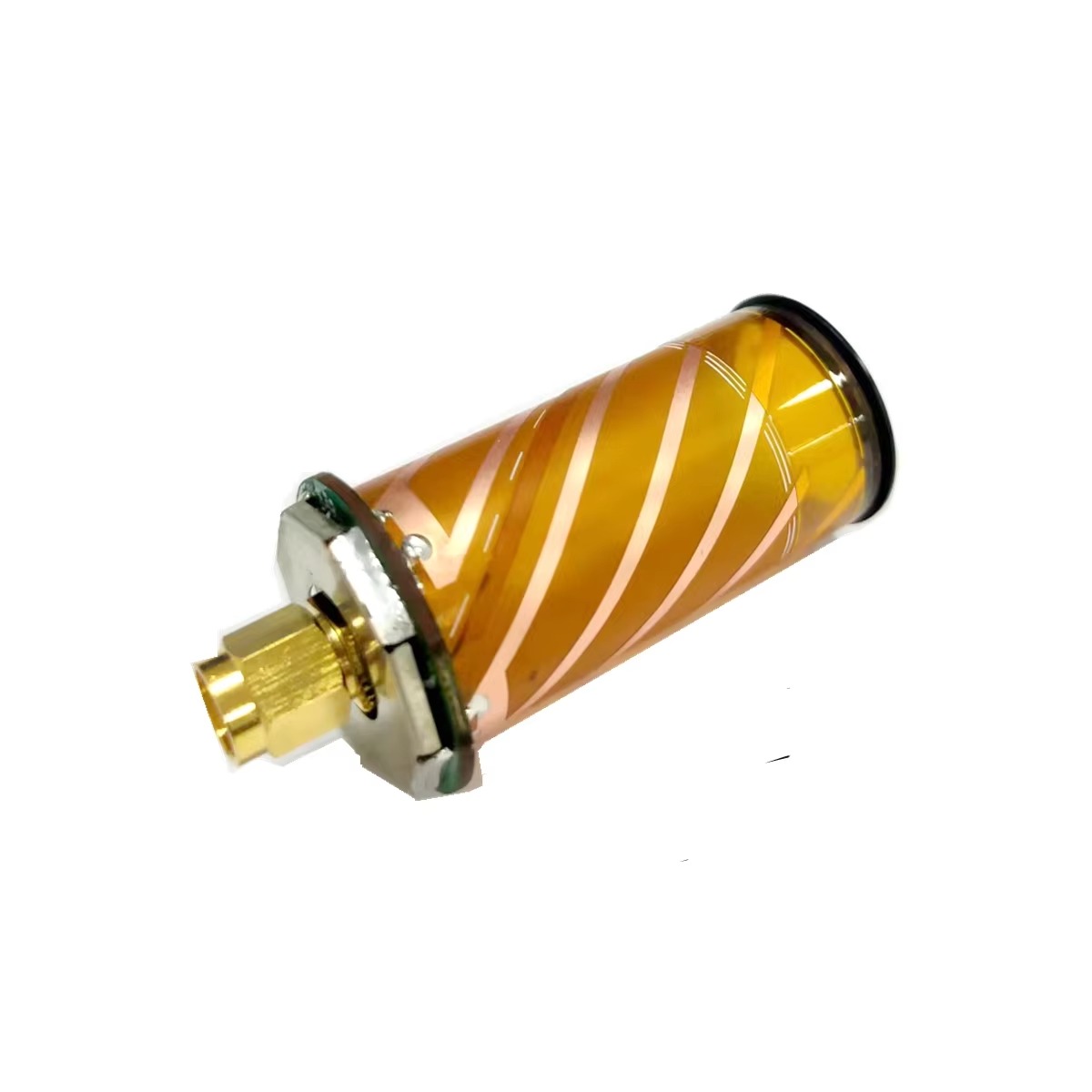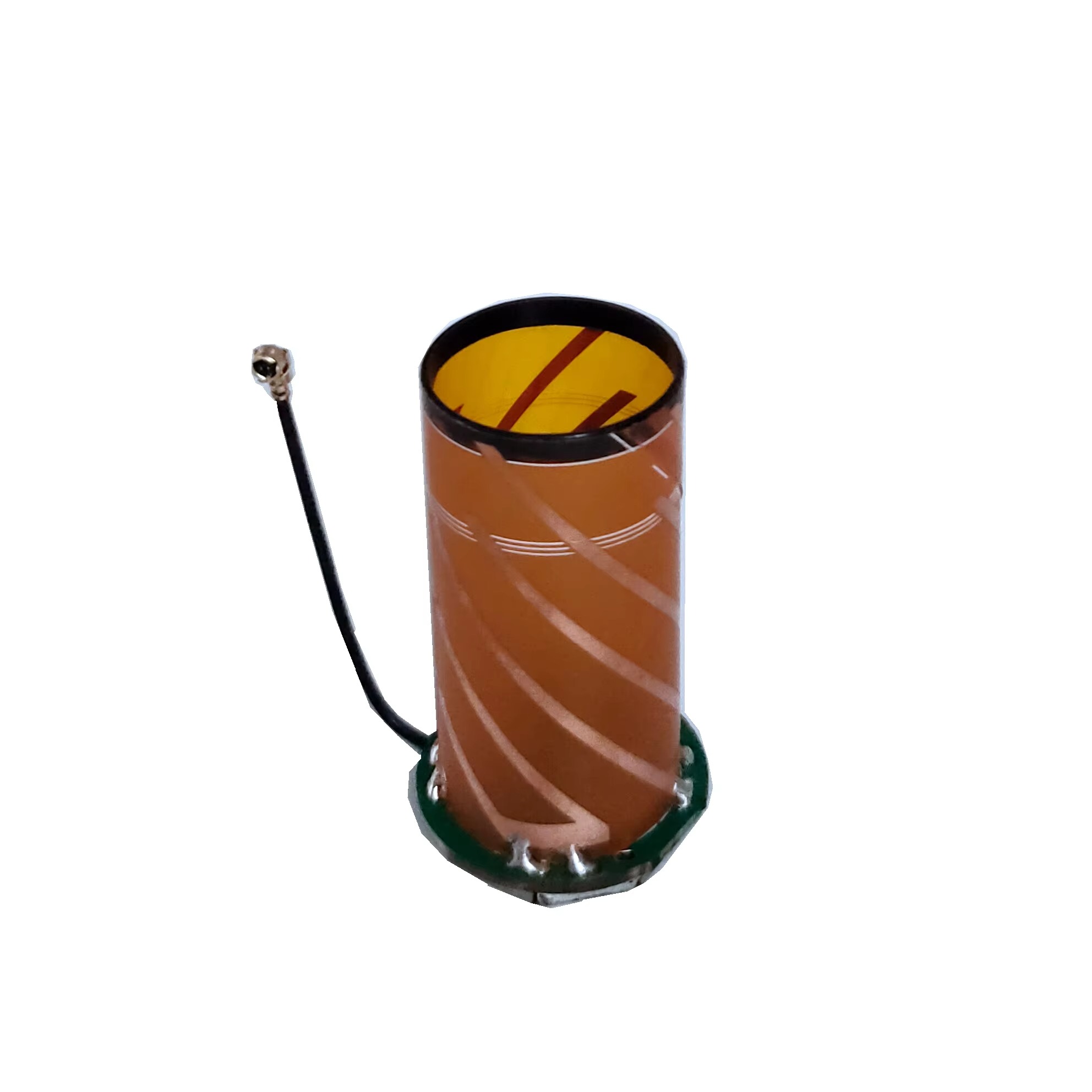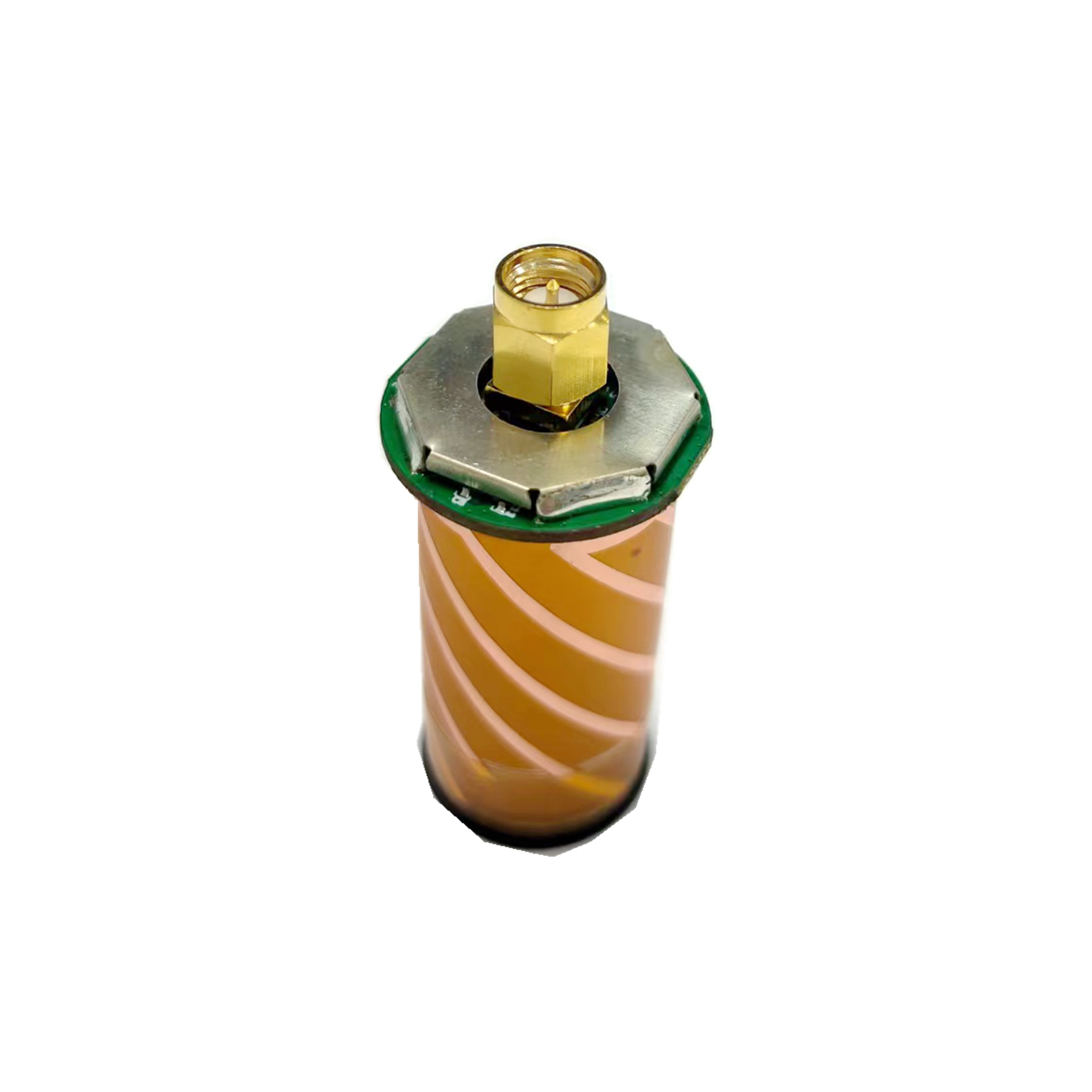the core of the Built-in GNSS RTK Helical Antenna
At the core of the Built-in GNSS RTK Helical Antenna’s performance is its helical design, a spiral-shaped radiating element that balances gain, directivity, and compactness. Unlike traditional patch antennas, which rely on planar radiators, a helical antenna uses a coiled conductor to enhance signal capture, particularly for weak or low-elevation satellite signals critical for RTK calculations. The helix’s spiral structure increases the effective length of the radiating element within a small volume, enabling it to resonate efficiently across the 1560-1602 MHz frequency band while maintaining the antenna’s 25 x 25 x 4mm footprint. This design is particularly valuable for RTK applications, which require strong, stable signals to process the subtle phase differences between satellite transmissions and ground-based reference data. The helix’s directional radiation pattern—focused upward toward the sky—minimizes interference from ground-based noise sources, such as urban infrastructure or industrial equipment, ensuring that the antenna prioritizes valid satellite signals. For example, in a drone’s navigation module, the helical design captures signals from satellites even at low angles, a common scenario when flying near buildings or terrain, ensuring that RTK corrections are applied accurately to maintain stable hover and precise waypoint navigation.
The integration of ceramic and PCB (FR4) materials further enhances the antenna’s performance and suitability for embedded systems. The helical element is mounted on a ceramic substrate with a high dielectric constant, which reduces the wavelength of electromagnetic signals, allowing the helix to achieve resonance within the antenna’s compact dimensions. Ceramic’s thermal stability—critical for maintaining resonance across the operating temperature range (-20°C to +85°C)—ensures that the antenna performs consistently in environments with fluctuating heat, such as automotive engine bays or outdoor industrial sensors. The ceramic substrate is bonded to an FR4 PCB, which serves as a ground plane and mounting base. FR4, a glass-reinforced epoxy laminate, provides mechanical rigidity, ensuring that the delicate helical element remains aligned during manufacturing and operation. As a ground plane, the PCB shapes the antenna’s radiation pattern, suppressing backward radiation to minimize interference from nearby electronics. This is particularly important in densely packed PCBs, where components like microprocessors and power regulators emit electromagnetic noise that could corrupt GNSS signals. The FR4 substrate also facilitates seamless integration into mass-produced devices, as it can be soldered directly to the main circuit board during automated assembly, reducing production costs and ensuring consistent performance across units.
IPX connectivity (U.FL) is a key feature that aligns with the antenna’s focus on miniaturization and integration into compact devices. IPX connectors are ultra-small, with a snap-on design that adds minimal height to the antenna assembly—essential for applications where vertical space is limited, such as slim IoT sensors or wearable trackers. The IPX interface ensures a low-loss connection to the GNSS receiver, with a precision-machined center pin that minimizes signal leakage, critical for preserving the weak RTK correction signals. While IPX connectors are not as robust as threaded alternatives (e.g., SMA) in high-vibration environments, their integration into the antenna’s PCB mitigates this risk: the antenna is protected within the device’s housing, shielding the connector from physical stress. For manufacturers, IPX simplifies automated assembly, as the connectors can be surface-mounted using standard pick-and-place equipment, enabling high-volume production of devices like consumer drones or industrial trackers. This compatibility with mass-manufacturing processes makes the antenna an attractive choice for OEMs scaling up production of RTK-enabled products, ensuring that precision positioning is accessible even in cost-sensitive markets.
Linear polarity is a deliberate design choice, optimized for applications where the antenna’s orientation remains fixed relative to satellite signals—a common scenario in embedded systems. Unlike circularly polarized antennas, which counteract polarization rotation caused by the ionosphere, linear polarization aligns the antenna’s electric field along a specific axis (vertical or horizontal). This alignment maximizes signal capture efficiency in devices with a consistent orientation, such as dashboard-mounted automotive sensors or stationary industrial beacons, where the antenna’s position relative to the sky remains stable. In RTK systems, this stability is critical, as polarization mismatch can introduce phase errors that degrade positioning accuracy. While linear polarity is more susceptible to multipath interference—where reflected signals arrive with altered polarization—the helical design mitigates this by focusing on direct signals, a trade-off that prioritizes RTK performance in controlled orientations. For example, in a surveying sensor mounted on a tripod, the antenna’s linear polarity, aligned vertically, ensures that signals from overhead satellites are captured with minimal loss, allowing the RTK system to achieve centimeter-level measurement accuracy.
antenna’s frequency range
The antenna’s frequency range of 1560-1602 MHz is strategically chosen to support multiple GNSS constellations, a key requirement for reliable RTK performance across global regions. This range includes GPS L1 (1575.42 MHz), BeiDou B1 (1561.098 MHz), and GLONASS G1 (1602 MHz), enabling the antenna to tap into signals from the U.S., Chinese, and Russian satellite systems. Multi-constellation support increases the number of visible satellites, reducing the risk of signal blockages and improving the robustness of RTK calculations. In urban environments, where skyscrapers may obstruct GPS signals, the antenna can rely on BeiDou or GLONASS to maintain a stable fix, ensuring that RTK corrections are applied without interruption. For global OEMs, this broad frequency coverage eliminates the need for region-specific antenna designs, simplifying inventory management and ensuring that devices work reliably in markets from North America to Asia. The frequency range also provides a buffer for minor shifts caused by satellite motion or ionospheric activity, ensuring that the antenna remains tuned to the correct signals.
A typical gain of 1.5 dB reflects the antenna’s balance of miniaturization and performance, ensuring that even weak signals are amplified sufficiently for RTK processing. While this gain is lower than that of larger external RTK antennas (which may offer 5-10 dB), it is optimized for the antenna’s compact size and embedded placement, where the close proximity to the receiver minimizes cable loss. The gain is consistent across the 1560-1602 MHz band, ensuring that signals from GPS, BeiDou, and GLONASS are amplified uniformly, a critical factor in multi-constellation RTK systems. In practice, this means that signals from low-elevation satellites—common in challenging environments like valleys or urban canyons—are boosted to levels that allow the receiver to process RTK corrections. For example, in a robotic lawnmower navigating a backyard with trees, the antenna’s gain ensures that satellite signals filtering through the foliage are strong enough to maintain RTK accuracy, preventing the mower from straying into flower beds or walkways. The gain profile is also designed to avoid amplifying noise, a key consideration in dense PCBs where electromagnetic interference from other components could corrupt the signal.
VSWR (Voltage Standing Wave Ratio) specifications—2.0 at 1575 MHz and 3.5 at 1602 MHz—provide insight into the antenna’s efficiency in transferring signal power to the receiver, a critical factor in maintaining RTK accuracy. VSWR measures the mismatch between the antenna’s impedance and the 50-ohm standard of most GNSS receivers, with lower values indicating better power transfer. At GPS L1 (1575 MHz), a VSWR of 2.0 ensures that over 90% of the signal power is transferred, minimizing loss and maximizing the signal-to-noise ratio—essential for processing the subtle phase differences in RTK. At GLONASS G1 (1602 MHz), a VSWR of 3.5 is higher, meaning approximately 60% of power is transferred, a compromise made to support multiple bands in a compact design. This trade-off is acceptable because GLONASS often acts as a secondary constellation, supplementing GPS or BeiDou rather than serving as the primary signal source. Manufacturers can further optimize performance by integrating impedance-matching circuits in the receiver, ensuring that even at 1602 MHz, the signal is efficiently processed. For end-users, these VSWR values ensure reliable operation across the antenna’s intended frequency range, with priority given to the most widely used band (GPS L1) for consistent RTK performance.
An impedance of 50 ohms aligns the antenna with industry standards for RF systems, ensuring seamless compatibility with GNSS receivers, coaxial cables, and other components in the RTK chain. Impedance matching is critical for maximizing power transfer and minimizing signal reflection, which can introduce phase errors that degrade RTK accuracy. By adhering to the 50-ohm standard, the antenna can be integrated into existing receiver designs without the need for additional matching components, simplifying OEM integration and reducing costs. This compatibility is particularly valuable for manufacturers using off-the-shelf RTK modules, as it eliminates the need for custom hardware modifications. Whether paired with a high-precision chipset in a surveying device or a cost-effective module in a consumer drone, the 50-ohm impedance ensures that signal loss is minimized, preserving the integrity of the RTK correction data.
The antenna’s compact size—25 x 25 x 4mm—enables integration into space-constrained devices where external RTK antennas are impractical. This miniature form factor fits easily into wearable tech, such as precision agriculture trackers worn by farmers, or into the control modules of small robots used in warehouse automation. The 4mm thickness is particularly noteworthy, allowing the antenna to be embedded in ultra-slim devices like foldable smartphones or tablet-based navigation systems, where traditional RTK antennas would be too bulky. Despite its small size, the antenna’s helical design ensures that it captures signals with sufficient strength to support RTK calculations, proving that high precision need not come at the cost of size. For example, in a portable mapping device used by hikers, the antenna’s compactness ensures that the device remains lightweight and easy to carry, while its RTK capabilities provide centimeter-level trail mapping—critical for search and rescue operations or land surveying in remote areas.
The RF1.37mm coaxial cable, with a 100mm length, is a critical component in maintaining signal integrity between the antenna and the RTK receiver. RF1.37mm cable is a miniature coaxial variant designed for high-frequency applications, with a small diameter that allows for easy routing within densely packed PCBs. Its construction includes a solid copper center conductor for efficient signal transmission, a dielectric insulator to minimize loss, a braided copper shield to block electromagnetic interference (EMI), and a flexible PVC outer jacket for durability. The braided shield is particularly important in embedded RTK systems, where the antenna is surrounded by noise-generating components like processors and power supplies. By blocking EMI, the shield ensures that the weak RTK correction signals are not corrupted before reaching the receiver, a critical factor in maintaining centimeter-level accuracy. The 100mm length is optimized for close-range integration: in most embedded systems, the antenna is mounted within centimeters of the receiver, reducing cable loss and ensuring that the signal remains strong. For manufacturers, the pre-attached cable simplifies assembly, as it can be soldered directly to the receiver during production, eliminating the need for manual connector attachment and reducing the risk of signal loss from poor connections.
The antenna’s operating temperature range
The antenna’s operating temperature range of -20°C to +85°C and storage temperature range of -20°C to +65°C ensure reliability in the diverse environments where RTK-enabled devices are used. In operating conditions, the ceramic substrate and helical element remain stable, maintaining their dielectric properties and resonance frequency even as temperatures fluctuate. This is critical for devices like automotive ADAS modules, which are exposed to cabin heat in summer and cold in winter, or outdoor sensors deployed in desert or arctic climates. The IPX connector and RF cable also withstand thermal stress: the cable’s insulation resists hardening in cold temperatures, preventing cracks that could expose the conductor, while the connector’s materials avoid warping in high heat, ensuring a secure connection. During storage, the antenna retains its performance characteristics, with no degradation after extended periods at -20°C to +65°C, a key consideration for OEMs managing inventory or shipping devices across global regions with varying climates.
The antenna’s applications—navigation modules, GNSS receivers, and OEM use—highlight its versatility across industries requiring high-precision positioning. In navigation modules for drones, it enables features like precise waypoint navigation and obstacle avoidance, relying on RTK accuracy to ensure safe, reliable flight. Its compact size allows integration into the drone’s flight controller, avoiding the aerodynamic drag of external antennas. In GNSS receivers for surveying and mapping, the antenna provides the stable signals needed to achieve centimeter-level measurements, even in challenging terrain. For example, a land surveyor using a handheld receiver equipped with this antenna can map property boundaries with unprecedented accuracy, reducing errors that could lead to legal disputes. For OEMs, the antenna’s support for OEM/ODM services enables customization, such as tuning the helical design for optimized performance in specific frequency bands or modifying the cable length to fit unique device layouts. This flexibility makes it a favorite among manufacturers developing proprietary RTK systems, from smart agriculture equipment to autonomous warehouse robots.
OEM/ODM support is a key advantage that sets the Built-in GNSS RTK Helical Antenna apart, allowing manufacturers to tailor the antenna to their specific RTK requirements. OEM services enable seamless integration into existing product lines, with minimal modifications to the antenna’s design. For example, a drone manufacturer can integrate the antenna into their flight controller PCB without altering the antenna’s form factor, ensuring compatibility with existing production lines. ODM services offer more extensive customization: manufacturers can request changes to the helical element’s pitch or diameter to optimize performance in specific frequency bands, modify the PCB layout to fit unique device casings, or adjust the cable length and connector type for specialized applications. This level of customization is invaluable for niche markets, such as precision agriculture, where antennas may need to operate in specific frequency bands or withstand exposure to moisture and chemicals. By supporting OEM/ODM, the antenna adapts to the diverse needs of the RTK market, ensuring that it remains a relevant solution for evolving technologies.
In practical use cases, the Built-in GNSS RTK Helical Antenna excels in scenarios where size and precision are equally important. In smart agriculture, it is integrated into tractor navigation systems, enabling RTK-guided planting and harvesting with centimeter accuracy, reducing seed waste and maximizing crop yields. The antenna’s compact size allows it to be embedded in the tractor’s dashboard, avoiding damage from debris or weather. In robotics, it powers autonomous warehouse robots, ensuring that they navigate narrow aisles with precise positioning, reducing collisions and improving efficiency. The antenna’s helical design captures signals even in the confined space of a warehouse, where metal racks can block satellite signals. In consumer electronics, it enables RTK capabilities in portable devices like hiking GPS units, providing adventurers with precise location data for backcountry navigation, where accurate mapping can be a matter of safety.
In conclusion
-
Looking to the future, the Built-in GNSS RTK Helical Antenna is well-positioned to support emerging trends in high-precision positioning. As satellite constellations expand—with new additions like Galileo and NavIC—the antenna’s broad frequency range ensures compatibility, future-proofing devices for global markets. The rise of 5G-integrated RTK, which uses cellular networks to transmit correction data, will further benefit from the antenna’s compact design, as 5G-enabled devices require miniaturized components. Advancements in ceramic materials, with even higher dielectric constants, could enable further miniaturization, allowing the antenna to fit into sub-10mm devices like smart glasses or medical trackers. For OEMs, the antenna’s adaptability and customization options ensure that it can evolve alongside these technologies, remaining a staple in embedded RTK solutions.
In conclusion, the Built-in GNSS RTK Helical Antenna represents a breakthrough in miniaturized high-precision positioning, combining the efficiency of a helical design with the compactness enabled by ceramic and PCB materials. Its IPX connectivity, linear polarity, and broad frequency range ensure seamless integration into navigation modules, GNSS receivers, and OEM devices, while its RTK capabilities deliver centimeter-level accuracy in space-constrained applications. Whether powering drones, robots, or portable sensors, this antenna proves that precision and size can coexist, enabling the next generation of embedded navigation solutions. As demand for high-precision positioning grows across industries, the Built-in GNSS RTK Helical Antenna will remain a critical component, driving innovation in how we navigate and interact with the world.




































































 Language
Language
 En
En Cn
Cn Korean
Korean

 Home >
Home > 







 18665803017 (Macro)
18665803017 (Macro)













